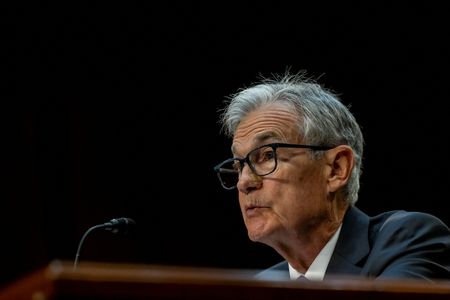By Ann Saphir and Howard Schneider
CHICAGO (Reuters) -The “last mile” of the Federal Reserve’s battle against inflation may have shortened to a last lap after U.S. consumer prices unexpectedly fell in June, shoring up policymakers’ confidence that they are winning the fight and paving the way to interest-rate cuts in coming months.
The consumer price index slid 0.1% last month after being unchanged in May, the Labor Department’s Bureau of Labor Statistics said on Thursday. It was the weakest monthly reading since May 2020, early in the pandemic, while the 3% year-over-year rise was the lowest reading in a year.
Over the past three months consumer prices have risen at just a 1% annual rate.
“This is what the path to 2% looks like,” Chicago Fed President Austan Goolsbee told reporters, calling the latest inflation data “excellent” and the improvement on what has been sticky housing inflation “profoundly encouraging.”
St Louis Fed President Alberto Musalem gave a slightly more muted thumbs up, calling it “encouraging further progress” toward the Fed’s 2% inflation target.
A “welcome relief,” said San Francisco Fed President Mary Daly, adding that the gradual easing of price pressures bolsters the case for lower interest rates even if the timing remains a matter for debate.
“With the information we have received today, which includes data on employment, inflation, growth, and the outlook for the economy, I see it as likely that policy adjustments, some policy adjustments, will be warranted,” Daly said. “Exactly when that happens … is still unclear.”
At the Fed’s July 30-31 meeting, the policy makers are expected to maintain the policy rate at 5.25%-5.5%, but they may set the table to lower rates in light of renewed progress on easing price pressures.
After July, the Fed’s next policy meeting is in mid-September.
Traders reacted swiftly to Thursday’s data, pricing in about a 90% chance of a September rate cut, up from about 70% earlier, and moving forward bets on a second rate cut to November, with about even odds of a third rate cut by year’s end.
Banking giant JPMorgan and Macquarie pulled forward their expectations for an initial rate cut to September from November and December, respectively.
“The doves have what they need” to cut rates even as soon as the July meeting, said Neil Dutta, Renaissance Macro’s head of economic research.
He added that while a July rate cut may be too abrupt for a central bank that, when possible, likes to flag decisions in advance to let the public adjust over time, rate cut proponents “should not leave the table unless Powell agrees to make a strong signal” for a cut in September.
Fed Chair Jerome Powell may not take much persuading.
In two days of testimony before Congress this week, Powell appeared to edge the door open to a September rate cut, saying that the U.S. economy was “no longer overheated” and that “more good data” on inflation would lay the groundwork to reduce the benchmark policy interest rate, which has been held in the 5.25% to 5.5% range for more than a year.
Fed officials consider the current rate “restrictive” on the economy. Between the easing of price pressures and a still modest-but-steady rise in the unemployment rate, they have begun actively considering rate cuts while becoming more concerned about slowing the economy too much.
June’s consumer price report may help solidify the case to begin easing policy, and a report due on Friday on producer prices could provide another potential building block.
The slowing of shelter inflation to 0.2% on the month, the weakest since August 2021, was “clearly the most important development,” said Inflation Insights President Omair Sharif, as Fed officials have been confident of a slowing in housing costs but were reluctant to act on that basis without evidence in official data.
Powell speaks in public again on Monday at the Economic Club of Washington, a prominent platform to share how the latest round of inflation is being interpreted by the central bank. Fed governors Christopher Waller, Adriana Kugler and Michelle Bowman are also slated to speak next week, the last speeches by Fed officials before July 20 when a communications blackout prior to the upcoming policy meeting is set to begin.
There will be particular focus on what changes may be made in the Fed’s July policy statement, and whether officials have decided they no longer need to refer to inflation as “elevated.”
Ahead of the July meeting, data on the Personal Consumption Expenditures Price Index for June will be released. The PCE index is used to set the Fed’s 2% inflation target and was last reported at 2.6%. The first estimate of second-quarter economic growth will also be out before the meeting, with Fed officials generally expecting the economy to be growing near trend but slower than last year.
“Today’s data sets the Fed up for September-December rate cuts, with the groundwork being laid at the July 31 meeting,” said III Capital Management Chief Economist Karim Basta.
(Reporting by Ann Saphir, Lucia Mutikani, Stephen Culp, Howard Schneider, Michael S. Derby; Editing by Toby Chopra, Chizu Nomiyama, Andrea Ricci and Richard Chang)












